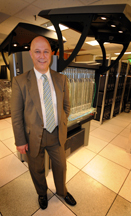
| RELATED INFO |
| * Office of Information Technology at Purdue |
| * SiCortex |

June 10, 2008
New green supercomputer powers up at Purdue
WEST LAFAYETTE, Ind. - |
But a new type of supercomputer installed this week at Purdue University, built by SiCortex, is like employing a fleet of thousands of bike messengers: Individually they don't carry much freight, but they use less energy and are more effective in some situations.
The supercomputer is the first of what is expected to be many new technologies used at Purdue and elsewhere to lower the energy demands of scientific research.
Gerry McCartney, vice president for information technology and chief information officer at Purdue, says the supercomputer, a SiCortex 5832, uses 40 times less power than traditional supercomputers.
"The net energy savings is significant. We expect to see a reduction of 75 percent to 80 percent of the costs of the energy and the associated costs of the cooling in using this machine," McCartney says. "But this is an experimental machine in the sense that we are just learning how to use it to make real scientific discoveries."
SiCortex, based in Boston, is a new computing company that produces systems designed specifically for high performance computing used in research supercomputers. Argonne National Laboratory also has installed one of the energy efficient machines.
"Energy use has become one of the biggest challenges in conducting scientific research," McCartney says. "It's not just the power the computer itself uses, which can be significant, but also the air conditioning. Supercomputers are the prima donnas of the computing world. They're like a star insisting on a special dressing room. These machines require special facilities called data centers where we pump in massive amounts of extra air conditioning or they literally self-destruct.
"The electricity needs of the supercomputers and the associated cooling can sometimes limit the amount of science that can be done."
A recent research paper from the U.S. Department of Energy's Lawrence Berkeley National Laboratory said that for a climate model to look at what is happening down to scales of one kilometer would require a supercomputer that would use 200 megawatts of power. That is the same amount of electricity used by a city with a population of 100,000.
"The energy issue is something we are going to have to solve in order to make significant scientific advances," McCartney says.
The SiCortex 5832 is about the size of two refrigerators, and it has with DeLorean-style gull-wing doors, which gives it a "Back to the Future" vibe (although it is missing a flux capacitor).
Its processors draw just 600 milliwatts of power each, or about the same power requirements as a cell phone or small flashlight. By comparison, a standard supercomputer contains thousands of processors that require about 25 watts (25,000 milliwatts) of energy each.
The SiCortex computer uses a non-traditional architecture to achieve the power savings, and eliminates parts of the processor that aren't needed for supercomputers that would otherwise expend energy. Also, because of the technology used, it is cheaper to buy than comparable supercomputers.
"With these advantages one might ask, 'Why don't you replace all of your supercomputers with this machine?'" McCartney says. "The reason is that this type of computer architecture works better for some kinds of science than others, and part of why we're acquiring the SiCortex is so we can learn how to do more science with this type of computer."
Research scientists in Purdue's Office of Information Technology will explore what kind of computational tasks can work on the new class of machines and possibly even rewrite software so they can run common science applications.
Rudolf Eigenmann, professor of electrical and computer engineering and interim director of Purdue's Computing Research Institute, says faculty researchers are already using the new machine.
"There are science applications that are already well adapted to this type of computing, such as research in chemistry and genetics, and even nano-electronics," Eigenmann says. "We've put this computer to use from the first day, but we will also be looking for more areas in which we can use lower-power computing."
Purdue scientists will be exploring new ways to conduct research so this type of computer machine can begin to replace other supercomputers on campus.
"At Purdue we have a team of talented research scientists in our central computing division who focus on improving scientific computing, so it makes sense for us to be among the first to look at this new technology to see how it can be used for discovery," McCartney says.
Writer: Steve Tally, (765) 494-9809, tally@purdue.edu
Sources: Gerry McCartney, (765) 496-2270, mccart@purdue.edu
Rudolf Eigenmann, (765) 494-1741, eigenman@purdue.edu
Purdue News Service: (765) 494-2096; purduenews@purdue.edu
Note to Journalists: A photo of Purdue CIO Gerry McCartney with the SiCortex supercomputer is available, as is broadcast-quality video of McCartney discussing energy use in computing. Contact Steve Tally, (765) 494-9809, tally@purdue.edu
PHOTO CAPTION:
Energy-efficient computing is becoming essential for science, says Purdue University’s Gerry McCartney, vice president for information technology and chief information officer, shown here standing in front of a SiCortex supercomputer that uses less power than traditional machines. McCartney says the energy costs of supercomputers is constraining science in some areas, prompting a need for new technologies. (Purdue News Service photo by David Umberger.)
To the News Service home page
If you have trouble accessing this page because of a disability, please contact Purdue News Service at purduenews@purdue.edu.
